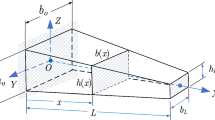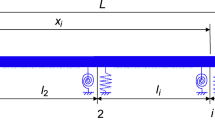Abstract
In this paper, a new three-node element is proposed for analysis of beams with shear deformation effect. In each node of this element, there exist translation and rotation degrees of freedom. The element’s formulation is based on the first-order shear deformation theory. For this aim, the displacement field of the element is approximated by a fifth-order polynomial. The shear strain is varied as a quadratic function within the element. It is worth noting that the quadratic function can be used for axial displacement field as well. By employing curvature and shear strain relations of Timoshenko beam theory, the exact and explicit shape functions of the displacement fields are obtained. By utilizing these shape functions, the stiffness matrix and the geometric stiffness matrix of the element are calculated. The mass matrices of the proposed element are derived from kinetic energy relation of the beam. Finally, several numerical tests are performed to assess the robustness of the developed element. The results of the numerical tests prove the absence of the shear locking and demonstrate high accuracy and efficiency of the proposed element for bending, free vibration and stability analysis of Timoshenko beams.








Similar content being viewed by others
References
Thomas D, Wilson J, Wilson R (1973) Timoshenko beam finite elements. J Sound Vib 31:315–330
Nickel R, Secor G (1972) Convergence of consistently derived Timoshenko beam finite elements. Int J Numer Meth Eng 5:243–252
Reddy J (1997) On locking-free shear deformable beam finite elements. Comput Methods Appl Mech Eng 149:113–132
Friedman Z, Kosmatka JB (1993) An improved two-node Timoshenko beam finite element. Comput Struct 47:473–481
Kapur KK (1966) Vibrations of a Timoshenko beam, using finite-element approach. J Acoust Soc Am 40:1058–1063
Lees A, Thomas D (1982) Unified Timoshenko beam finite element. J Sound Vib 80:355–366
Lees A, Thomas D (1985) Modal hierarchical Timoshenko beam finite elements. J Sound Vib 99:455–461
Tessler A, Dong S (1981) On a hierarchy of conforming Timoshenko beam elements. Comput Struct 14:335–344
Falsone G, Settineri D (2011) An Euler–Bernoulli-like finite element method for Timoshenko beams. Mech Res Commun 38:12–16
Bouclier R, Elguedj T, Combescure A (2012) Locking free isogeometric formulations of curved thick beams. Comput Methods Appl Mech Eng 245:144–162
Cazzani A, Malagù M, Turco E (2016) Isogeometric analysis of plane-curved beams. Math Mech Solids 21:562–577
Lepe F, Mora D, Rodríguez R (2014) Locking-free finite element method for a bending moment formulation of Timoshenko beams. Comput Math Appl 68:118–131
Caillerie D, Kotronis P, Cybulski R (2015) A Timoshenko finite element straight beam with internal degrees of freedom. Int J Numer Anal Meth Geomech 39:1753–1773
Khajavi R (2016) A novel stiffness/flexibility-based method for Euler–Bernoulli/Timoshenko beams with multiple discontinuities and singularities. Appl Math Model 40(17–18):7627–7655
Dawe D (1978) A finite element for the vibration analysis of Timoshenko beams. J Sound Vib 60:11–20
Lee J, Schultz W (2004) Eigenvalue analysis of Timoshenko beams and axisymmetric Mindlin plates by the pseudospectral method. J Sound Vib 269:609–621
Kocatürk T, Şimşek M (2005) Free vibration analysis of Timoshenko beams under various boundary conditions. Sigma 1:30–44
Ferreira A (2005) Free vibration analysis of Timoshenko beams and Mindlin plates by radial basis functions. Int J Comput Methods 2:15–31
Ferreira A, Fasshauer G (2006) Computation of natural frequencies of shear deformable beams and plates by an RBF-pseudospectral method. Comput Methods Appl Mech Eng 196:134–146
Xu S, Wang X (2011) Free vibration analyses of Timoshenko beams with free edges by using the discrete singular convolution. Adv Eng Softw 42:797–806
Lee SJ, Park KS (2013) Vibrations of Timoshenko beams with isogeometric approach. Appl Math Model 37:9174–9190
Moallemi-Oreh A, Karkon M (2013) Finite element formulation for stability and free vibration analysis of Timoshenko beam. Adv Acoust Vib 2013:841215. https://doi.org/10.1155/2013/841215
Hsu YS (2016) Enriched finite element methods for Timoshenko beam free vibration analysis. Appl Math Model 40:7012–7033
Kosmatka J (1995) An improved two-node finite element for stability and natural frequencies of axial-loaded Timoshenko beams. Comput Struct 57:141–149
Matsunaga H (1996) Buckling instabilities of thick elastic beams subjected to axial stresses. Comput Struct 59:859–868
Więckowski Z, Golubiewski M (2007) Improvement in accuracy of the finite element method in analysis of stability of Euler–Bernoulli and Timoshenko beams. Thin Walled Struct 45:950–954
Carrera E, Pagani A, Banerjee JR (2016) Linearized buckling analysis of isotropic and composite beam-columns by Carrera Unified Formulation and dynamic stiffness method. Mech Adv Mater Struct 23:1092–1103
Coulter BA, Miller RE (1986) Vibration and buckling of beam-columns subjected to non-uniform axial loads. Int J Numer Meth Eng 23:1739–1755
Augarde CE (1998) Generation of shape functions for straight beam elements. Comput Struct 68:555–560
Modarakar Haghighi A, Zakeri M, Attarnejad R (2015) 3-node basic displacement functions in analysis of non-prismatic beams. J Comput Appl Mech 46:77–91
Ferreira AJ (2008) MATLAB codes for finite element analysis: solids and structures, vol 157. Springer, Berlin
Bažant ZP, Cedolin L (2010) Stability of structures: elastic, inelastic, fracture and damage theories. World Scientific, Singapore
Author information
Authors and Affiliations
Corresponding author
Additional information
Technical Editor: Paulo de Tarso Rocha de Mendonça.
Appendix
Appendix
The nonzero entries of the stiffness matrix \(\left[ {K^{e} } \right]\) is:
The nonzero entries of the translation mass matrix \(\left[ {M_{1}^{e} } \right]\) is:
The nonzero entries of the rotary mass matrix \(\left[ {M_{2}^{e} } \right]\) is:
The nonzero entries of the geometric stiffness matrix \(\left[ {K_{g} } \right]\) is:
Rights and permissions
About this article
Cite this article
Karkon, M. An efficient finite element formulation for bending, free vibration and stability analysis of Timoshenko beams. J Braz. Soc. Mech. Sci. Eng. 40, 497 (2018). https://doi.org/10.1007/s40430-018-1413-0
Received:
Accepted:
Published:
DOI: https://doi.org/10.1007/s40430-018-1413-0




